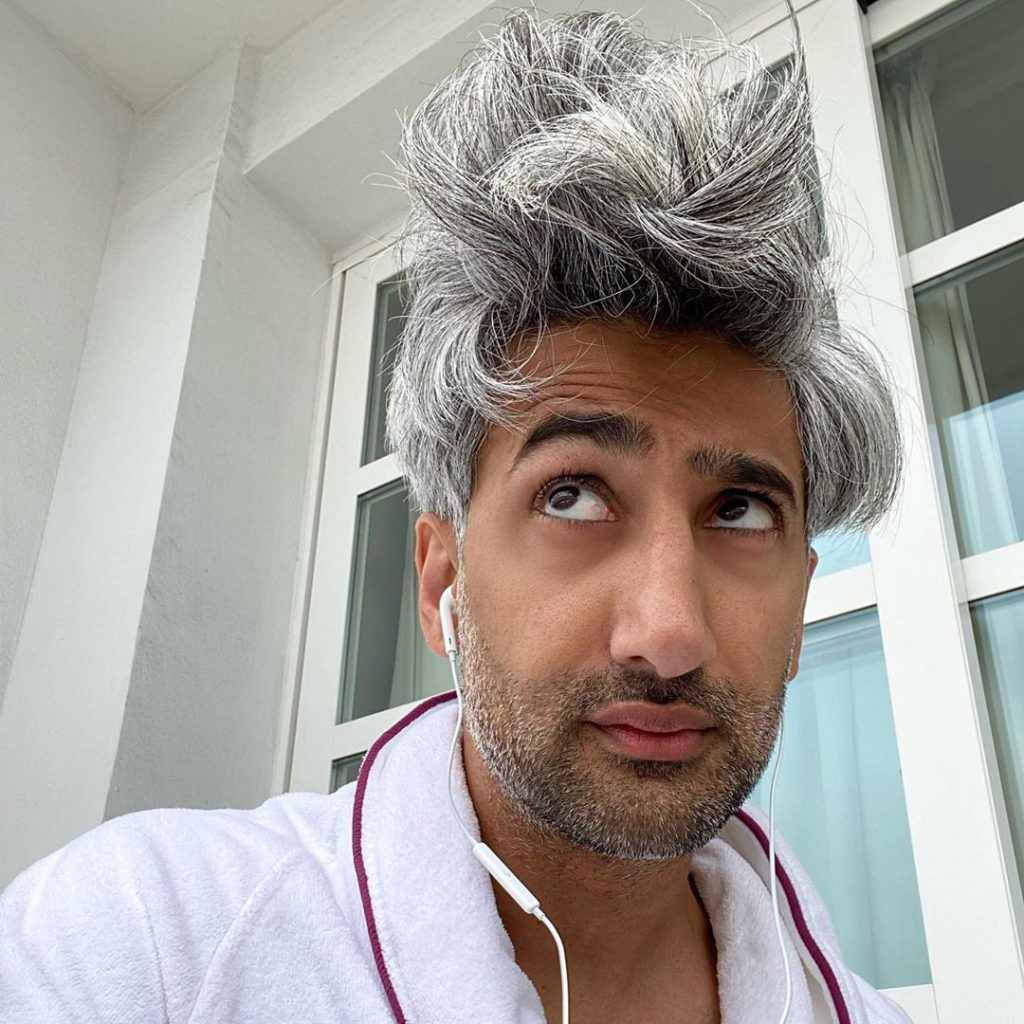
In these days of temporarily shuttered salons and barbershops, many men, including me, are finding that this is the longest they’ve gone without a haircut. Most days, I try to manage my hair with a baseball cap or a bandana. But I’ve also resorted to using different combs to set my hair into place.
Most men have at least a comb in their dopp kit, but many don’t have much more. When it comes to familiarity with hair care products, or what kind of products you might need, a lot depends on where you get your hair cut and how you style your hair. By and large, the world of hairstyling can be separated out into two experiences: barbershops vs. salons.
Some men find the word salon to be intimidating. The word has been feminized, much like the word perfume (even though perfume just refers to the concentration of perfume oils and nothing to do with the type of scent). It’s true that salons are staffed by hairstylists trained in cutting men’s and women’s hair. But the main difference for men will be about hairstyle. Barbers specialize in short, traditional styles: tight fades, shape ups, edge ups, crewcuts, and the like. On the other hand, hairstylists tend to be better at longer hairstyles and specialty services such as coloring. Your hair doesn’t even have to be that long for you to be better served at a hair salon — just a few inches long, such as what you’d want for a quiff, will do.
This difference can define the sorts of products you’ll find at these establishments. Barbershops tend to be more traditional and centered on shaving and close-cut hairstyles. Taylor of Old Bond Street in London, for example, is one of the oldest and most famous barbershops in the world (today, they’re located on Jermyn Street and simply called Taylor’s). Step into their premises, and you’ll find soft badger bristle shaving brushes, almond-scented soaps and creams, and items made from the soft skeletal structures of simple sea creatures. They also sell their own brand of men’s hairbrushes and combs. Military-style brushes are backed with hardwood or imitation ivory. Their deep, concave backs are designed to fit comfortably in your palm. Additionally, they carry combs of nearly every kind: pocket combs, folding combs, mustache combs, oversized rakes, and combination combs with fine and coarse teeth.
While salons also stock combs and brushes, they’ll also have a wider variety of products aimed at styling longer hair (something like Patrick Dempsey’s above). This includes clays, pastes, pre-styling treatments, finishing sprays, and texturizing products. You can also find specialized combs and brushes, such as round combs, paddle brushes, vented brushes, and a variety of brushes made from technologically advanced and traditional materials alike (e.g., ceramic, plastic, and boar bristle). Each of these brushes has its own fringe benefits (sorry, this will be my only pun in this post). Here are some things you can use to keep your hair in check as it grows past barbershop territory — and maybe continue to use after quarantine if you’ve found your new favorite hairstyle.
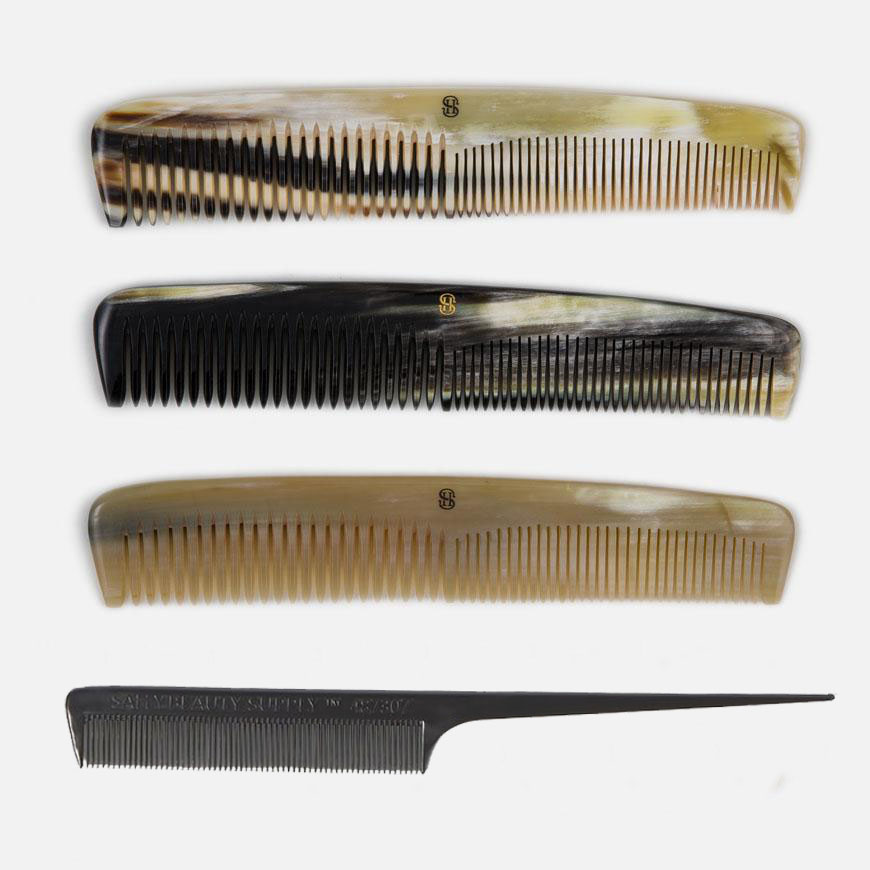
Basic Combs
Combs are particularly useful for clean-cut, neatly set styles, such as slicked back hair, pompadours, and Don Draper’s hard side parts. Combination combs with fine and coarse teeth are the most popular. These are easy to hold and give you greater control of your hairstyle. However, if you like a hard side part, you may want a rat tail comb (such as the bottom-most comb pictured above). The long, skinny handle can be harder to grip, but you can flip the comb around and use that sharp end to set a cleaner looking part.
When purchasing a comb, avoid ones that have been made with injection-molded plastic. Some of those will have tiny ridges, known as mold marks, either at the tips or between the teeth. Those ridges can scratch and snag your hair, causing breakage and ultimately split ends.
Instead, find something seamless that has been buffed and smoothed. Higher-end combs will often be made from cellulose acetate designed to look like imitation ivory or tortoiseshell, or they’ll be cut from oxhorn. You can find such combs at Taylor of Old Bond Street, Cable Car Clothier, Fendrihan, O’Connell’s, and The Hanger Project.

Paddle Brush (Or Paul Mitchell’s Sculpting Brush)
Paddle brushes are your next most common hairstyling tool. Often large and rectangular, they’re defined by widely spaced, plastic teeth, which are set on a cushion and then finished with rounded nibs. These teeth are extra flexible, which makes them exceptionally gentle on your hair.
Why would you use a paddle brush? For one, it’s a simple hair styling tool that can be used to distribute hair product evenly. It also sets your hair without making it look too neat, as would happen with a comb. Most importantly, as hair grows longer, you need to give it some extra attention. Paddle brushes are especially useful for detangling your hair when it’s wet (which is when it’s the most fragile). Most days, I use a paddle comb when getting out of the shower, instead of a comb, to roughly set my hair in place.
I recommend Paul Mitchell’s 413 Sculpting Brush. It’s a narrow paddle brush with flexible, plastic teeth set on a bendy cushion. Since it’s smaller than a traditional paddle brush, it’s easier to use for hairstyling. You can use the brush to grip your hair and pull it upwards to give it volume. Large, rectangular paddle brushes will detangle your hair faster, but they can be a bit unwieldy.
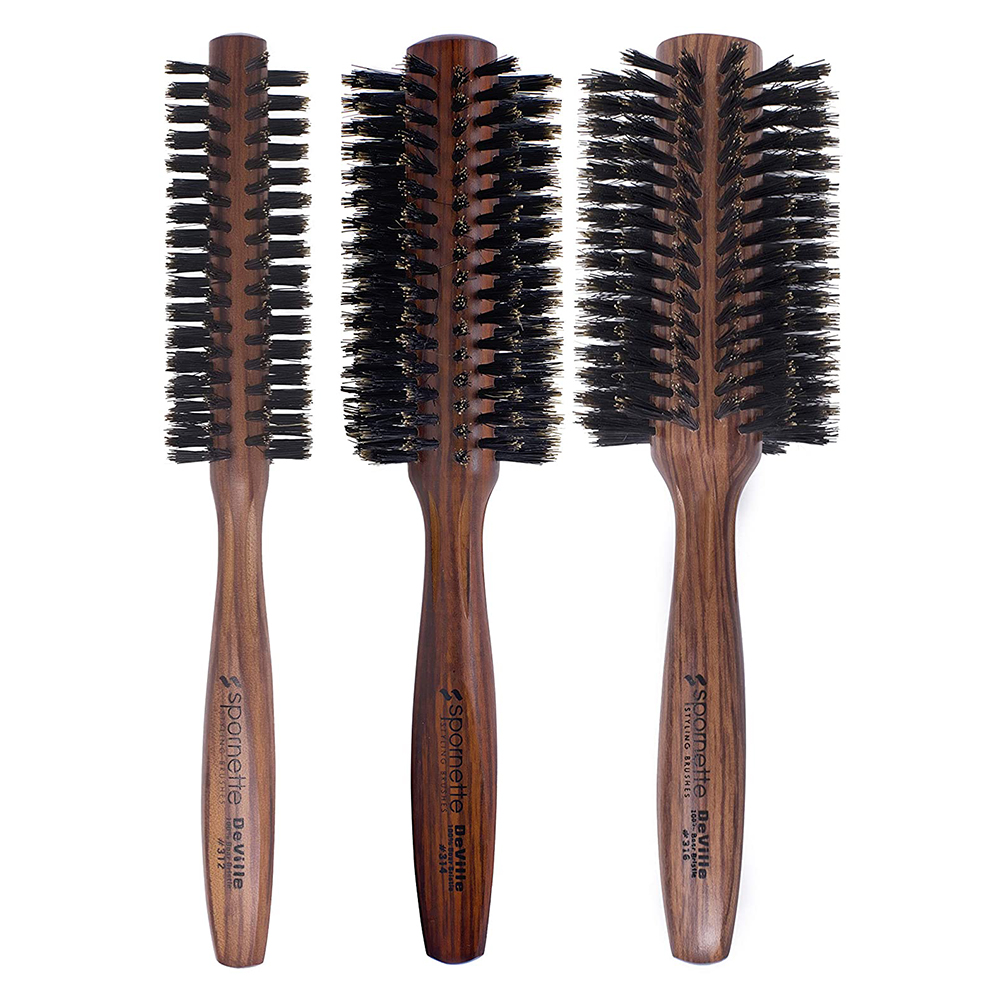
Boar Bristle Round Brush
Beyond your basic combs and paddle brushes, you have boar bristle brushes, which, as their name suggests, are constructed from the thick, coarse brisles of boars. These bristles have tiny hooks on them, which grip your hair and allow you to pull and shape it. Being of East Asian descent, my hair is pin straight, but coarse, thick, and unruly. Like many Asian men, I find that if my hair is too short on the sides, it sticks out like the quills on a frightened porcupine. So I leave the sides of my hair a little longer and use a boar bristle brush to comb it back, making it lay flat. The key is rolling the brush back, so you can really pull the hair tight and force it into shape. Boar bristle brushes are really useful for minimizing frizz and smoothing out hair. This isn’t something you can easily achieve with other kinds of brushes, as they don’t grip your hair in the same way.
Boar bristle brushes come in all shapes and sizes: flat, curved, rounded, and half-round. Rounded brushes, such as the one you see above, are particularly useful for putting extra tension on your hair, as you can twist them to lock your hair in place. Choose a size that’s right for you. If you have longer hair, you’ll want a brush with a larger diameter. You can also buy half round brushes if you want that sharp edge to get a cleanly defined side part.
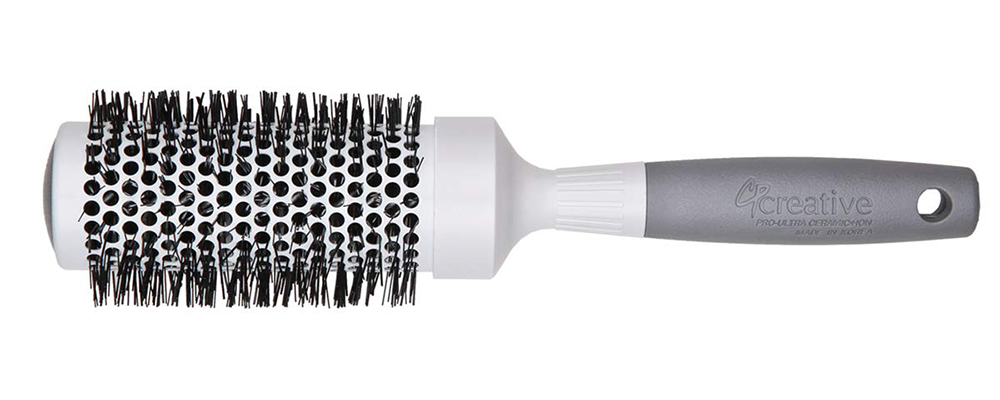
Ceramic Round Brush
Ceramic brushes are your other hair shaping tool. In tailoring, a tailor sets shape into a suit jacket or sport coat by pressing it with a heavy and hot iron. Tailored clothes are made with animal hair — not just the shell fabric, but also the horsehair that goes into the interior (often the haircloth, which is what builds up that chest shape). Since hair has memory, it can be pressed into shape and retain that shape long after the coat leaves a tailoring shop.
Your hair is the same. If you think your hair is limp and lifeless, you can use a hairdryer and ceramic brush to give it definition, waves, or volume. The technique requires a bit of skill and practice, but not much. Essentially, you want to replicate what a tailor does at a tailoring shop. Roll the brush backward on your hair — rolling it gently will give it waves, pulling it up will give it volume. With your hairdryer on heat, you can then “press” your hair into shape. The heat from your hairdryer will heat up your brush’s ceramic plate. Don’t worry about burning your hair; so long as you keep your hairdryer moving, it should be fine. In the end, blast your hair with cold air to set it into place.
When purchasing a ceramic round brush, take note of the size. Guys with longer hair will want brushes with a larger diameter. The good news is that these brushes are relatively cheap, so it’s not too expensive to experiment.
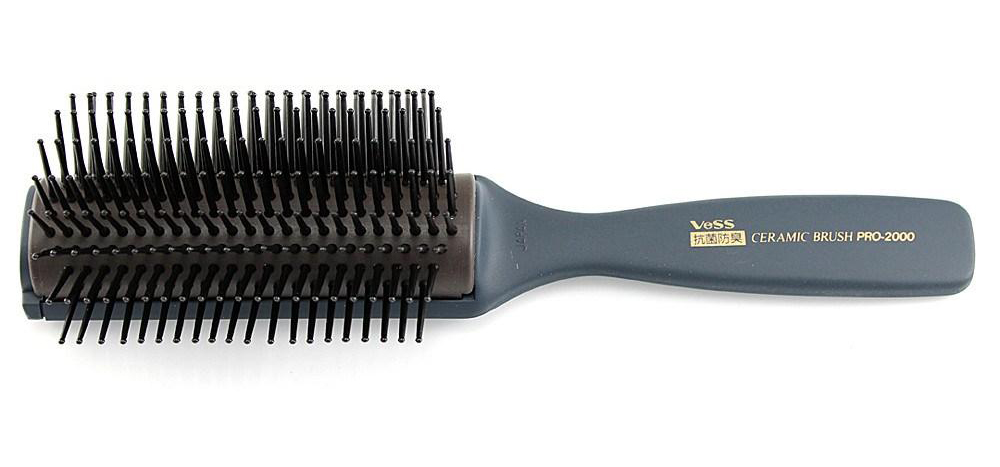
Denman and Vented Brushes
Let’s say you still find all this stuff confusing, and you’re not sure where to start. Consider getting a Denman, a company that has been making specialized brushes since the 1930s. Their seven- and nine-row brushes — called so for the number of rows they have for bristles — are considered a staple in many hairstyling kits. They’re popular because they’re gentle, which makes them useful for detangling longer hair. The grippy bristles also allow you to control and shape your hair during a blow drying process.
On Amazon, you can find Denman’s original stylers for about $15 to $20. Voss also makes a Denman-like brush with a ceramic plate, if you want to achieve more shaping. Vented brushes are also similar and can be found for less than $10. However, since they’re vented, they’re designed not to heat up very much. That may or may not be right for you, depending on how you plan to shape your hair.







